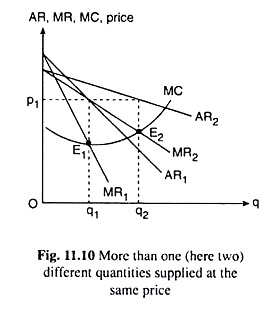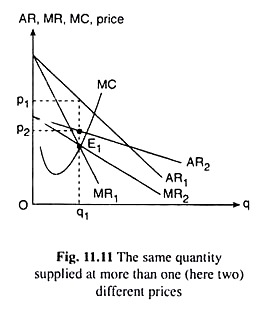In this article we will discuss about the supply curve of a firm under perfect competition and monopoly.
The supply curve of a firm (or of an industry) is one that tells us the quantity of output that would be supplied per period by the firm (or the industry) at any particular price so that the firm (or the firms within the industry) may earn the maximum possible amount of profit.
In the monopolistic market, of course, the firm itself is the industry. In order to understand whether there can be a supply curve of the monopolist firm, let us discuss first the conditions under which the firm may possess a supply curve.
We know that the firm and the industry under perfect competition have supply curves. This is because each firm in a competitive industry is a price-taker.
ADVERTISEMENTS:
Here each firm has to accept the price which is determined in the market (by way of interaction between market demand and market supply of the good) and, subject to that price, the firm has to determine the profit-maximising quantity of its output, which is its quantity supplied.
Therefore, under perfect competition, the quantity of output supplied by the firm is a function of the price of the good. As we know, in the short run, if the price of the good in a competitive market rises or falls, the quantity supplied by the firm also rises or falls.
That is, the short-run supply of a competitive firm is an increasing function of the price of its product (of course, if the price becomes less than the average variable cost, the firm’s supply would be zero).
Also, there is a one-to-one correspondence between the price and the quantity supplied. That is, at any particular price, there may be only one particular quantity supplied by the firm, and, conversely, only one price may be associated with any particular quantity supplied.
ADVERTISEMENTS:
These are the conditions under which we obtain the supply curve of a particular firm under perfect competition. Also, the short-run supply curve of a competitive industry is obtained as the horizontal summation of the SRS curves of all the firms within the industry.
It is now clear from the above discussion that there cannot be any supply curve of a monopolistic firm (or industry). Because, first, the firm here is not a price-taker. The firm can determine the equilibrium output and price simultaneously, given the revenue and cost curves.
Again, we shall see that, in the case of a monopoly-firm, more than one price of the good may be associated with a particular quantity supplied, and more than one quantity supplied may be associated with a particular price. In other words, under monopoly, a one-to-one relation between the price and quantity supplied does not exist.
That is, under monopoly, we cannot obtain a unique quantity supplied at any particular price and, also, we cannot obtain a unique price that is required for any particular quantity to be supplied. All this we can see with the help of Figs. 11.10 and 11.11.
In Fig. 11.10 the (short-run) marginal cost curve of the firm is MC. It is seen from the figure that the firm’s MR = MC equilibrium point is E1 when its AR and MR curves are AR1 and MR1 respectively. At E1, the firm supplies q1 of output at a price of p1.
But if, as a result of a change in the demand conditions, the AR and MR curves shift their positions and become AR2 and MR2, then the firm’s new equilibrium (MR = MC) point will be E2. At E2, the firm will supply a larger quantity q2 (q2 > q0 at the same price (= p1). That is, here, one price is associated with more than one output.
Again, in Fig. 11.11, the marginal cost curves of the firm is MC. Given this curve, if the AR and MR curves are AR1 and MR2, the MR = MC equilibrium point of the firm would be E1, where price and quantity supplied will be p1 and q1, respectively, But if the AR and MR curves were AR2 and MR2, the MR = MC equilibrium point of the firm would have been the same E1.
Now, the firm supplies the same quantity (q1) at a smaller price (p2). Therefore, here, a particular quantity of supply is associated with more than one price.
In the above discussion, we have seen that under monopoly a particular price may be associated with more than one quantity and a particular quantity may be associated with more than one price. Given the cost conditions, the demand conditions for the product would determine what price would be associated with what quantity.
Since, in the case of a monopoly firm, the one-to-one relation between price and supply does not exist, the supply curve of the firm and of the industry do not exist under monopoly.

